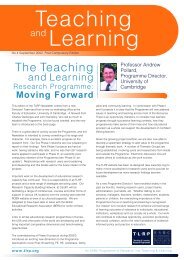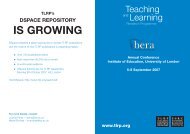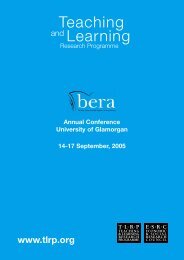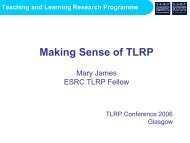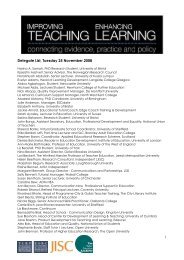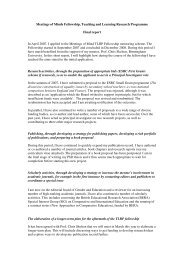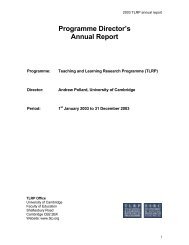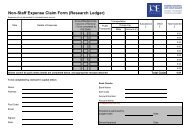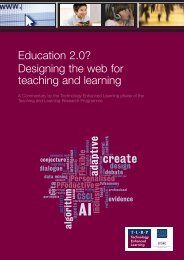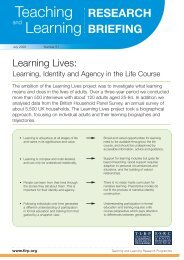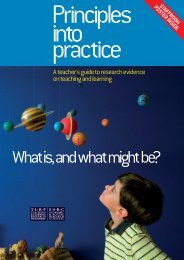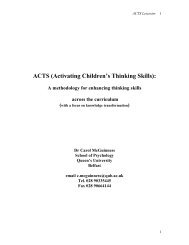Towards evidence-based practice in science education 1
Towards evidence-based practice in science education 1
Towards evidence-based practice in science education 1
- No tags were found...
You also want an ePaper? Increase the reach of your titles
YUMPU automatically turns print PDFs into web optimized ePapers that Google loves.
Teach<strong>in</strong>gandLearn<strong>in</strong>gRESEARCHBRIEFINGNumber 1<strong>Towards</strong> Evidence-<strong>based</strong> Practice<strong>in</strong> Science Education 1Us<strong>in</strong>g diagnostic assessment to enhance learn<strong>in</strong>gMuch research has been carried out on students’ understand<strong>in</strong>g of key <strong>science</strong> ideas, butthis has not led to marked improvement <strong>in</strong> teach<strong>in</strong>g and learn<strong>in</strong>g. As a means of improv<strong>in</strong>g<strong>practice</strong>, banks of diagnostic questions, <strong>based</strong> on research, were developed for several core<strong>science</strong> topics. These were used to monitor students’ understand<strong>in</strong>g of key <strong>science</strong> ideas,and to explore how the provision of research-<strong>based</strong> materials of this sort can <strong>in</strong>fluenceteachers’ <strong>practice</strong>s and students’ learn<strong>in</strong>g.• Science teachers’ <strong>practice</strong>, and students’learn<strong>in</strong>g, can be significantly enhanced byprovid<strong>in</strong>g teach<strong>in</strong>g materials that embodyresearch f<strong>in</strong>d<strong>in</strong>gs and <strong>in</strong>sights.If f<strong>in</strong>d<strong>in</strong>gs and <strong>in</strong>sights from research are‘translated’ <strong>in</strong>to specific practical implications,or teach<strong>in</strong>g materials, the likelihood and scaleof their impact on <strong>practice</strong> is greatly <strong>in</strong>creased.• Carefully designed probes, <strong>based</strong> onresearch, can provide quality <strong>in</strong>formationon students’ understand<strong>in</strong>g of key <strong>science</strong>ideas, and <strong>in</strong>form subsequent action.Tools for quickly ‘measur<strong>in</strong>g’ understand<strong>in</strong>g ofkey ideas can help focus learn<strong>in</strong>g activity and<strong>in</strong>dicate levels of understand<strong>in</strong>g across aclass. More should be developed and madeavailable to teachers.• The level of students’ understand<strong>in</strong>g ofmany fundamental <strong>science</strong> ideas is low,and <strong>in</strong>creases only slowly with age.Current teach<strong>in</strong>g approaches <strong>in</strong> <strong>science</strong> donot result <strong>in</strong> widespread understand<strong>in</strong>g ofmany core ideas. Levels of understand<strong>in</strong>g ofa few key ideas should be monitoredsystematically over time, to <strong>in</strong>form curriculumdecisions.www.tlrp.orgTeach<strong>in</strong>g and Learn<strong>in</strong>g Research Programme
The researchThe EPSE NetworkThis project is one of four undertaken by theEvidence-<strong>based</strong> Practice <strong>in</strong> ScienceEducation (EPSE) Research Network. TheNetwork is a collaboration <strong>in</strong>volv<strong>in</strong>g theUniversities of York, Leeds, Southampton andK<strong>in</strong>g’s College London. Its overall aim is toexplore ways of enhanc<strong>in</strong>g the impact ofresearch on <strong>practice</strong> and policy <strong>in</strong> <strong>science</strong><strong>education</strong>, by improv<strong>in</strong>g our understand<strong>in</strong>g ofthe <strong>in</strong>terface between researchers andpractitioners. The EPSE Network hasdeveloped and evaluated several examples of<strong>evidence</strong>-<strong>in</strong>formed <strong>practice</strong>, and has exploredpractitioners’ perceptions of the <strong>in</strong>fluence ofresearch on their <strong>practice</strong>. Whilst focuss<strong>in</strong>gon <strong>science</strong> <strong>education</strong>, the f<strong>in</strong>d<strong>in</strong>gs andoutcomes may also illum<strong>in</strong>ate the research<strong>practice</strong><strong>in</strong>terface <strong>in</strong> other subject areas.Background andrationaleOver the past 30 years, a great deal ofresearch has been carried out <strong>in</strong> manycountries on learners’ ideas about the naturalworld. This has helped identify commonlyheldideas which differ from the acceptedscientific view, and has shown that these areoften very resistant to change. Thesef<strong>in</strong>d<strong>in</strong>gs have clear implications for the paceand sequence of <strong>in</strong>struction <strong>in</strong> many <strong>science</strong>topics, particularly those which <strong>in</strong>volveunderstand<strong>in</strong>g of fundamental ideas andmodels. Yet whilst many teachers know ofthis research, it has had little systematicimpact on classroom <strong>practice</strong>s, or on<strong>science</strong> <strong>education</strong> policy <strong>in</strong> the UK.One response might be to try tocommunicate more effectively to teachers thef<strong>in</strong>d<strong>in</strong>gs of research on <strong>science</strong> learn<strong>in</strong>g.This, however, seems rarely to be an effectivestrategy for chang<strong>in</strong>g <strong>education</strong>al <strong>practice</strong>s.Instead, this project sought to <strong>in</strong>fluenceteachers’ <strong>practice</strong> by provid<strong>in</strong>g them withtools derived from research – a bank ofdiagnostic questions, <strong>based</strong> on the k<strong>in</strong>ds ofprobes used by researchers. This wouldenable them more easily to collect data ontheir own students’ learn<strong>in</strong>g of key ideas, andso adjust their teach<strong>in</strong>g <strong>in</strong> the light of this<strong>evidence</strong> of their own students’ learn<strong>in</strong>g.There is also another sense <strong>in</strong> which thisapproach can be seen as an example of<strong>evidence</strong>-<strong>based</strong> <strong>practice</strong>. A review by Blackand Wiliam (1998) of research on the use offormative assessment showed that this canlead to significant learn<strong>in</strong>g ga<strong>in</strong>s, throughclarify<strong>in</strong>g learn<strong>in</strong>g objectives, and provid<strong>in</strong>g<strong>in</strong>formative feedback to learners. A possibleobstacle, however, is the difficulty ofgenerat<strong>in</strong>g good formative assessmentquestions and tasks. By provid<strong>in</strong>g teacherswith a large bank of diagnostic questions, wecan explore the extent to which thisfacilitates change <strong>in</strong> <strong>practice</strong>, lead<strong>in</strong>g tobetter learn<strong>in</strong>g.www.tlrp.orgWhat we didThe first stage of the project was to developbanks of diagnostic questions. This wasdone <strong>in</strong> collaboration with a ‘partnershipgroup’ of practitioners, which <strong>in</strong>cludedseveral primary and secondary teachers, LEAadvisers, and writers of teach<strong>in</strong>g materials.This group chose the <strong>science</strong> topics for thiswork: electric circuits, forces and motion,particle models of matter, and life processes(digestion, respiration and photosynthesis),and acted as a critical ‘expert’ review groupthroughout. Diagnostic questions weretrialled <strong>in</strong> the partner teachers’ schools, withfollow-up <strong>in</strong>terviews with some students toprobe their understand<strong>in</strong>g further.Questions with a two-tier structure (Figure 1)were found to be particularly useful. The first‘tier’ asks for a prediction about what will beobserved – and the second then asks for thebest explanation for this. A correct answercomb<strong>in</strong>ation is a good <strong>in</strong>dicator ofunderstand<strong>in</strong>g. Other answer patterns<strong>in</strong>dicate common misconceptions.Questions were also developed with moreopen response formats, and to stimulatesmall-group discussion.The banks of diagnostic questions producedwere then used <strong>in</strong> two ways:• to evaluate students’ currentunderstand<strong>in</strong>g of some key ideas at theends of Key Stages 2, 3 and 4;• to monitor how a panel of teachers useddiagnostic question banks <strong>in</strong> their ownteach<strong>in</strong>g, and the impact on classroomactivity and student learn<strong>in</strong>g.Understand<strong>in</strong>g ofkey ideasRather than assess understand<strong>in</strong>g across the<strong>science</strong>s, as other surveys have done, wechose to probe students’ understand<strong>in</strong>g of afew ideas <strong>in</strong> depth. The samples of studentstested came from a range of schools, andwere above the national average for eachage group (from predicted national testscores). Two important outcomes emerged.First, the proportion of students able todemonstrate understand<strong>in</strong>g of some verybasic ideas <strong>in</strong> these topic areas was low, andoften <strong>in</strong>creased little with age. Fewer than50% at age 14 understood that electriccurrent is the same everywhere around aseries circuit; the proportion at age 16 wasalmost identical. Ideas that build on this,Q2current current other TOTALthe same graduallyused upQ1 current the same 65 46 4 115current gradually used up 11 63 4 78other 6 7 4 17TOTAL 82 116 12 210Table 1 Models used by Key Stage 3 pupils <strong>in</strong> two questions on electric currentabout the relationships between voltage,current and resistance <strong>in</strong> simple circuits, weregrasped by fewer than 20% of 16 year-olds.Less than a quarter showed soundunderstand<strong>in</strong>g of the forces act<strong>in</strong>g on objectsmov<strong>in</strong>g at steady speed or slow<strong>in</strong>g down.Only about half at age 14 (ris<strong>in</strong>g to about60% by age 16) understood that mass isconserved <strong>in</strong> physical and chemical changes.Over 50% at age 14 wrongly classified someparticle-level illustrations of mixtures andcompounds, and of physical and chemicalchange. These results are not especially newor surpris<strong>in</strong>g – <strong>in</strong>deed they corroboratef<strong>in</strong>d<strong>in</strong>gs of studies that predate the NationalCurriculum. But they <strong>in</strong>dicate that currentapproaches to the teach<strong>in</strong>g of <strong>science</strong> do notlead, for many students, to a soundunderstand<strong>in</strong>g of many basic explanatoryideas – and that this is not highlighted bycurrent measures of student performance.A second important outcome concerns howwe measure ‘understand<strong>in</strong>g’. Most researchstudies, like exam<strong>in</strong>ations, probe each keyidea with a s<strong>in</strong>gle question. Instead, weused several, to explore the consistency of<strong>in</strong>dividual students’ responses. We foundsurpris<strong>in</strong>g variation <strong>in</strong> the models used <strong>in</strong>different questions prob<strong>in</strong>g the same idea.Table 1 shows one example. Of the 115students who used the correct scientificmodel <strong>in</strong> Q1 (<strong>in</strong> Figure 1), only 65 did soaga<strong>in</strong> <strong>in</strong> Q2. Either question alone is adubious <strong>in</strong>dicator of understand<strong>in</strong>g. Wefound similar <strong>in</strong>consistencies <strong>in</strong> answers onother <strong>science</strong> ideas. Clearly any measure of‘understand<strong>in</strong>g’ must <strong>in</strong>clude severalquestions on each idea tested, and state acriterion for ‘understand<strong>in</strong>g’. Agreedoutcome measures are a pre-requisite forexperimental comparisons of programmes orteach<strong>in</strong>g approaches. Even for topics wheretargets can be readily agreed, develop<strong>in</strong>gsuch measures is a considerable task.Help<strong>in</strong>g teachersuse diagnosticassessmentIn the f<strong>in</strong>al phase of the project, we exploredhow provision of diagnostic materials might<strong>in</strong>fluence teachers’ <strong>practice</strong>s and studentlearn<strong>in</strong>g. Twenty teachers, <strong>in</strong>clud<strong>in</strong>g somefrom the project partnership group, weregiven a bank of diagnostic questions for achosen <strong>science</strong> topic, with some suggestionson possible ways of us<strong>in</strong>g them. Interviewswith these teachers explored how they usedthe materials and its impact on their teach<strong>in</strong>g.Teach<strong>in</strong>g and Learn<strong>in</strong>g Research Programme
Not surpris<strong>in</strong>gly, some teachers’ <strong>in</strong>itialreaction was ‘oh good, questions – we’re soshort of useful questions’. Several chosefrom the banks to make up new end-of-topictests: ‘we needed a new test … so I looked<strong>in</strong> the pack … and just pulled a selectionout’. A few talked of us<strong>in</strong>g the banks todevelop pre-tests for a new topic, ‘to f<strong>in</strong>d outwhat their <strong>in</strong>itial ideas were before we thenmoved on’. This opens up the possibility ofmore responsive teach<strong>in</strong>g, tak<strong>in</strong>g students’exist<strong>in</strong>g ideas <strong>in</strong>to account.Many teachers were hesitant about <strong>in</strong>creas<strong>in</strong>gthe amount of test<strong>in</strong>g: ‘we do so many tests.I wanted a more flexible way, that wouldenable me to see where the problems were <strong>in</strong>their th<strong>in</strong>k<strong>in</strong>g and move them forward.’ Othercomments strongly re<strong>in</strong>forced this viewpo<strong>in</strong>t.One teacher commented that she had <strong>in</strong>itiallyseen the banks as test items but quicklycame to the view that: ‘the use for me isopen<strong>in</strong>g up discussion, th<strong>in</strong>k<strong>in</strong>g about howthey’re actually perceiv<strong>in</strong>g th<strong>in</strong>gs.’ Strik<strong>in</strong>gly,more than half of the group highlighted:‘discussion with the pupils … these haveprompted a great deal, which wouldn’t havebeen there without them’. For some, thiswas a development of their teach<strong>in</strong>g style.One acknowledged that, ‘if I was the sort ofteacher that was always prompt<strong>in</strong>gdiscussion, then it probably wouldn’t havebeen a necessity, I wouldn’t have neededthat. But I did and it’s helped, withoutquestion. I’m hav<strong>in</strong>g more discussions <strong>in</strong>class than previously.’ For another it was amatter of see<strong>in</strong>g how to use: ‘a much more<strong>in</strong>teractive, discursive approach … a style ofteach<strong>in</strong>g I prefer. … perhaps I haven’t beenconfident <strong>in</strong> physics before to risk it. This hasgiven me an impetus.’ An NQT felt that thequestion banks helped clarify her ownunderstand<strong>in</strong>g, and highlighted key po<strong>in</strong>ts toteach.Almost all were positive about students’engagement <strong>in</strong> lessons us<strong>in</strong>g diagnosticquestions, with several comment<strong>in</strong>g thatmultiple-choice questions prompted morelively discussion than open-response ones,as they obliged students to evaluatealternative viewpo<strong>in</strong>ts: ‘What I got, from oneEPSE question, was an entire unplannedlesson, with pupils fully engaged and mak<strong>in</strong>greal progress with their th<strong>in</strong>k<strong>in</strong>g.’The majority of teachers <strong>in</strong>volved <strong>in</strong> the studyreported changes, of vary<strong>in</strong>g degree, <strong>in</strong> theirteach<strong>in</strong>g styles, or their approach to the<strong>science</strong> topic <strong>in</strong> question. All planned tocont<strong>in</strong>ue us<strong>in</strong>g the materials and teach<strong>in</strong>gapproaches they had begun to explore. Allwere conv<strong>in</strong>ced that students’ understand<strong>in</strong>g– and <strong>in</strong> some cases also their ownunderstand<strong>in</strong>g – of the ideas that reallymatter had been significantly improved. Thisexploratory study demonstrates the potentialfor <strong>in</strong>fluenc<strong>in</strong>g <strong>practice</strong> through the provisionof teach<strong>in</strong>g materials <strong>based</strong> on research, anddeveloped through collaboration betweenteachers and researchers.ReferenceBlack, P. & Wiliam, D. (1998). Inside the BlackBox. Rais<strong>in</strong>g standards through classroomassessment. London: K<strong>in</strong>g’s College,School of Education.Major implicationsThis work has shown that teachers’ <strong>practice</strong>can be significantly <strong>in</strong>fluenced by mak<strong>in</strong>gavailable teach<strong>in</strong>g materials <strong>based</strong> onresearch f<strong>in</strong>d<strong>in</strong>gs and <strong>in</strong>sights. In thisproject, the <strong>practice</strong>s of a group of teacherswere significantly enhanced (<strong>in</strong> their own viewand that of the researchers) by access tobanks of diagnostic questions <strong>in</strong>formed bythe f<strong>in</strong>d<strong>in</strong>gs of research on concept learn<strong>in</strong>g,and by researchers’ analyses of subjectmatter and experience <strong>in</strong> prob<strong>in</strong>gunderstand<strong>in</strong>g. These helped teachers toidentify more precisely, and to focus teach<strong>in</strong>gmore strongly on, the key ideas that are atthe heart of an understand<strong>in</strong>g of these<strong>science</strong> topics, and which provide a basis forfurther learn<strong>in</strong>g. Teachers valued how thequestions enabled them quickly to assessthe understand<strong>in</strong>g of all the students <strong>in</strong> aclass, rather than sampl<strong>in</strong>g a few <strong>in</strong>dividuals.They also found structured diagnosticquestions particularly useful for stimulat<strong>in</strong>gsmall-group and whole-class discussion, andreported high levels of student engagement,and lively debate about ideas andexplanations, often provid<strong>in</strong>g clear <strong>evidence</strong>of student learn<strong>in</strong>g. Several felt thatdiagnostic materials helped them to teach<strong>science</strong> topics outside their specialist area <strong>in</strong>more <strong>in</strong>teractive ways, and with a clearerunderstand<strong>in</strong>g of which ideas to emphasise.Similar banks of diagnostic materials areneeded for other <strong>science</strong> topics with similarconceptual demands, perhaps draw<strong>in</strong>g onthe experience of current national projects <strong>in</strong>New Zealand and Australia to develop web<strong>based</strong>banks of assessment resources forteachers. Ways of encourag<strong>in</strong>g moresystematic formative assessment us<strong>in</strong>g thesematerials also need to be further explored,perhaps by restructur<strong>in</strong>g our materials or byprovid<strong>in</strong>g more targeted CPD. L<strong>in</strong>k<strong>in</strong>g our‘provision of materials’ approach to othercurrent projects seek<strong>in</strong>g to develop formativeclassroom assessment might be a means of<strong>in</strong>creas<strong>in</strong>g impact on <strong>practice</strong>.The large banks of diagnostic questionsproduced are <strong>in</strong> themselves a major outcomeof this project. They embody a huge amountof accumulated knowledge from research,Their ‘translation’ from research tools <strong>in</strong>toteach<strong>in</strong>g materials <strong>in</strong>volved significantcreative <strong>in</strong>put; the outcomes are newartefacts. Articulation of f<strong>in</strong>d<strong>in</strong>gs <strong>in</strong> the formof specific practical implications or usabletools needs to be more generally and widelyseen as a necessary and critical part of theprocess by which <strong>education</strong>al research might<strong>in</strong>fluence <strong>practice</strong>. The development ofdiagnostic question banks required detailedanalyses of subject content <strong>in</strong> each <strong>science</strong>topic; learn<strong>in</strong>g objectives then had to beoperationalised as tasks provid<strong>in</strong>g differentialdiagnosis (of students who do/do notunderstand a po<strong>in</strong>t). This is a severe test ofthe way ideas are stated and sequenced <strong>in</strong>curricula and teach<strong>in</strong>g schemes. In ourwork, it highlighted significant problems <strong>in</strong>the sequence of ideas <strong>in</strong> several areas,particularly mechanics (forces and motion).Here key ideas <strong>in</strong> the learn<strong>in</strong>g sequence (likethat all forces arise from <strong>in</strong>teractions and soalways come <strong>in</strong> pairs) are unduly delayed,and some critical ideas (like identify<strong>in</strong>g clearlywhich object each force is act<strong>in</strong>g on) are<strong>in</strong>sufficiently emphasised. By draw<strong>in</strong>g<strong>in</strong>felicities of this sort to attention, and byclarify<strong>in</strong>g expectations of what studentsshould be able to do, the development ofdiagnostic questions cover<strong>in</strong>g the whole<strong>science</strong> curriculum could lead to significantimprovement of <strong>practice</strong> and outcome.F<strong>in</strong>ally, this work has shown that the level ofunderstand<strong>in</strong>g among students of many keyideas <strong>in</strong> <strong>science</strong> is low, that <strong>in</strong> many cases it<strong>in</strong>creases only very slowly with age, and thatwell-known misconceptions are prevalent. Itseems clear that current approaches to theteach<strong>in</strong>g of <strong>science</strong> do not developwidespread understand<strong>in</strong>g of many coreideas <strong>in</strong> the <strong>science</strong> doma<strong>in</strong>s studied. This,however, is not <strong>in</strong>evitable. Teachers, whenus<strong>in</strong>g our diagnostic question banks, notedthat many students actually engage muchmore strongly with these basic ideas, if giventime and space to th<strong>in</strong>k about them, thanwith their normal <strong>science</strong> diet. It also seemsclear that current measures of studentperformance <strong>in</strong> <strong>science</strong> do not detect andhighlight these gaps <strong>in</strong> fundamentalunderstand<strong>in</strong>g. Whilst it is not possible tocollect exhaustive data on every idea thatmight be deemed important, somesystematic data collection should beundertaken, and ma<strong>in</strong>ta<strong>in</strong>ed over time, tomonitor levels of understand<strong>in</strong>g of a few keyideas as students progress through theirschool careers, as a means of monitor<strong>in</strong>g thecurriculum and its effectiveness.Figure 1 A two-tier question on electriccircuitsTeach<strong>in</strong>g and Learn<strong>in</strong>g Research Programmewww.tlrp.org



